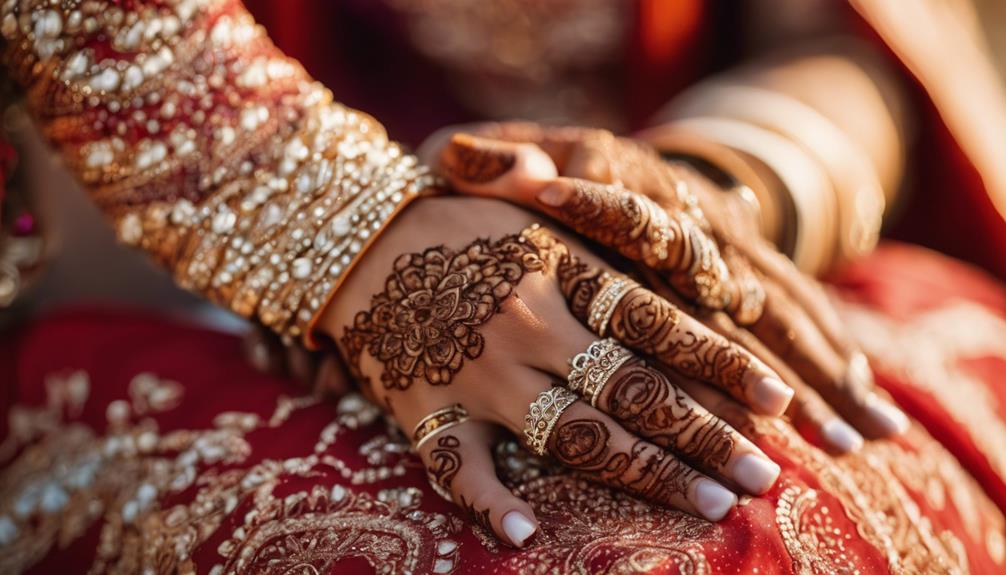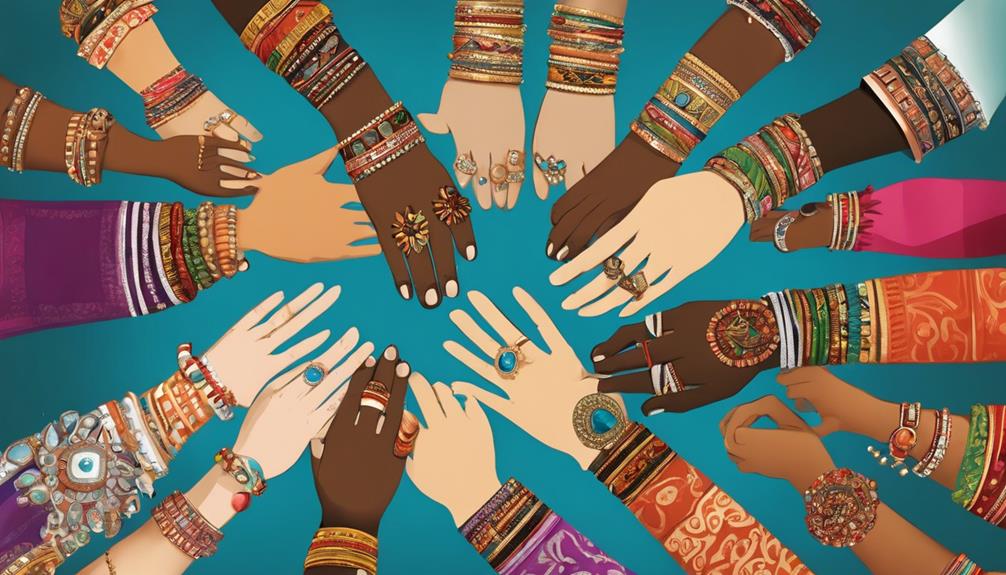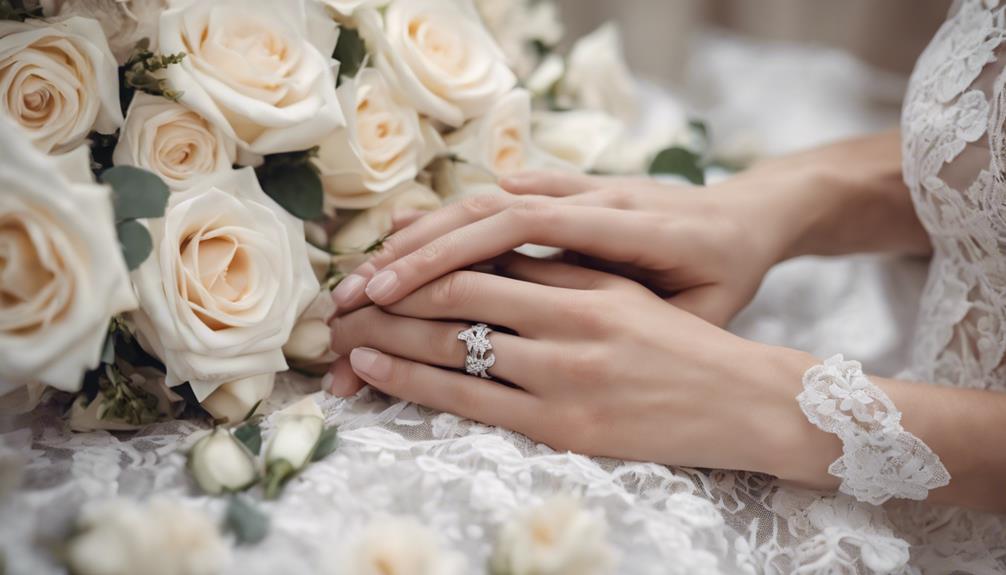In many cultures, wearing a wedding ring on the right hand is rich with tradition and symbolisms. Countries like Russia, Germany, and India view the right hand as a symbol of purity and virtue, making it a natural choice for wedding rings. Eastern Orthodox Christians choose the right hand during ceremonies to reflect divine blessings. The right hand is also associated with trust and loyalty. It’s not uncommon for Jewish ceremonies to start with a ring on the right hand, later moving it to the left. Same-sex couples might select the right hand to signify commitment. Explore how these traditions shape meaning.
Wedding Ring Finger Traditions

When it comes to wedding ring finger traditions, there’s a fascinating variety of customs across different cultures. In many Western societies, the wedding ring tradition involves wearing engagement and wedding rings on the left hand. This practice stems from the ancient belief in the “vena amoris,” a vein thought to connect directly to the heart, symbolizing love.
However, not all cultures follow this norm. In places like Russia, Germany, and India, it’s common to see wedding rings proudly worn on the right hand. This tradition is often linked to cultural norms that associate the right side with cleanliness and virtue.
Eastern Orthodox Christians, for instance, place wedding rings on the right hand during ceremonies, reflecting their belief that the right hand symbolizes blessings. Jewish wedding traditions also involve placing the ring on the right hand, with some later moving it to the left to align with broader cultural practices.
Personal preferences also play a role, especially among same-sex couples and left-handed individuals, who might choose the right hand for practical reasons. Whether on the right or left, these traditions highlight the rich diversity in how people celebrate love and commitment globally.
Right Hand Ring Symbolism
The symbolism of wearing a wedding ring on the right hand is rich and varied, rooted in cultural beliefs and traditions. In many cultures, the right hand represents cleanliness, trust, and loyalty, making it a favored choice for displaying a wedding ring. This practice isn’t just about tradition; it carries profound meaning that resonates on multiple levels.
- Cultural Beliefs: In countries like Greece, Russia, and India, people often wear their wedding rings on the right hand. This tradition stems from cultural beliefs where the right hand is seen as pure and virtuous, reflecting the sanctity of marriage.
- Religious Significance: The Eastern Orthodox Christian tradition places emphasis on wearing wedding rings on the right hand during ceremonies. This act symbolizes a closer relationship with God, intertwining faith with marital commitment.
- Same-Sex Couples: Many same-sex couples choose the right-hand ring symbolism to express their commitment. This choice aligns with historical associations of honor and loyalty, offering a meaningful alternative to conventional practices.
Each of these elements reflects a deeper connection between personal beliefs and societal norms, making the right hand more than just a practical choice for wearing a wedding ring.
Cultural Practices Worldwide

Understanding the global landscape of wedding ring traditions reveals a rich tapestry of cultural practices. When you explore this subject, you’ll find that wearing a wedding ring on the right hand is prevalent in many cultures, each with its unique rationale.
In Eastern European countries like Bulgaria, Greece, and Poland, the right hand is chosen for its associations with cleanliness and virtue. This tradition highlights the deep cultural beliefs that influence how marital symbols are perceived.
In India, the practice stems from cultural views that regard the left hand as impure, making the right hand the preferred choice for wedding rings.
For Eastern Orthodox Christians, wearing the wedding ring on the right hand during ceremonies symbolizes a closer connection with God and His blessings. This tradition underscores the religious significance placed on the right hand in their ceremonies.
In Jewish tradition, the wedding ring is often placed on the right hand during the ceremony. However, many couples later move it to the left hand, blending cultural and personal choices.
Additionally, countries like Russia, Belgium, and Portugal embrace wearing wedding rings on the right hand, showcasing varied interpretations of marital symbolism across different cultures.
Historical Context and Significance
Throughout history, the tradition of wearing wedding rings on the right hand has been shaped by cultural beliefs and religious practices. This custom is deeply rooted in the historical context of various societies, each attributing unique meanings to the right hand.
Eastern European cultures, such as Bulgaria, Greece, and Russia, maintain this tradition primarily due to cultural beliefs associating the right hand with purity and virtue. This practice isn’t just a fleeting trend but a long-standing tradition that has endured through generations.
In the domain of religious customs, the Eastern Orthodox Christian tradition places a wedding ring on the right hand during ceremonies. This act symbolizes blessings and a strengthened relationship with God, highlighting the significance of the right hand in spiritual contexts.
To give you a clearer picture:
- Eastern European Tradition: Many countries, including Russia and Greece, wear wedding rings on the right hand, reflecting beliefs about purity.
- Eastern Orthodox Christianity: The right hand symbolizes divine blessings in wedding ceremonies.
- Jewish Customs: Rings are placed on the right hand during the ceremony, blending tradition with modern practices.
Personal Preferences and Choices

Choosing to wear your wedding ring on the right hand can be a deeply personal decision influenced by various factors. For many, it reflects unique personal preferences and cultural practices. You might find that wearing your wedding ring on the right hand aligns with your cultural or familial traditions, as seen in countries like Greece and Latvia, where this practice symbolizes loyalty and honor.
For same-sex couples, choosing the right hand for their wedding rings can hold particular significance. It can represent their monogamous commitment and align with personal identities, offering a subtle yet powerful statement about their relationship. This choice provides a meaningful way to express love and commitment beyond conventional norms.
If you’re left-handed, wearing your wedding ring on the right hand might simply be a practical choice. It can prevent discomfort and damage, as the right hand is typically non-dominant.
Additionally, personal comfort and style preferences play a significant role in where you choose to wear your ring. You might favor the right hand if it feels more comfortable or complements your style, allowing your commitment to be expressed in a way that truly resonates with you.
Conclusion
By choosing to wear your wedding ring on your right hand, you’re embracing a tradition that’s both unique and meaningful. You’re not just honoring cultural practices from places like Latvia, Greece, or Russia; you’re also making a personal statement. Whether it’s for practical reasons or as an expression of individuality, this choice reflects your commitment to loyalty and trust. So, wear it proudly, knowing it symbolizes love and respect in a way that’s uniquely yours.



